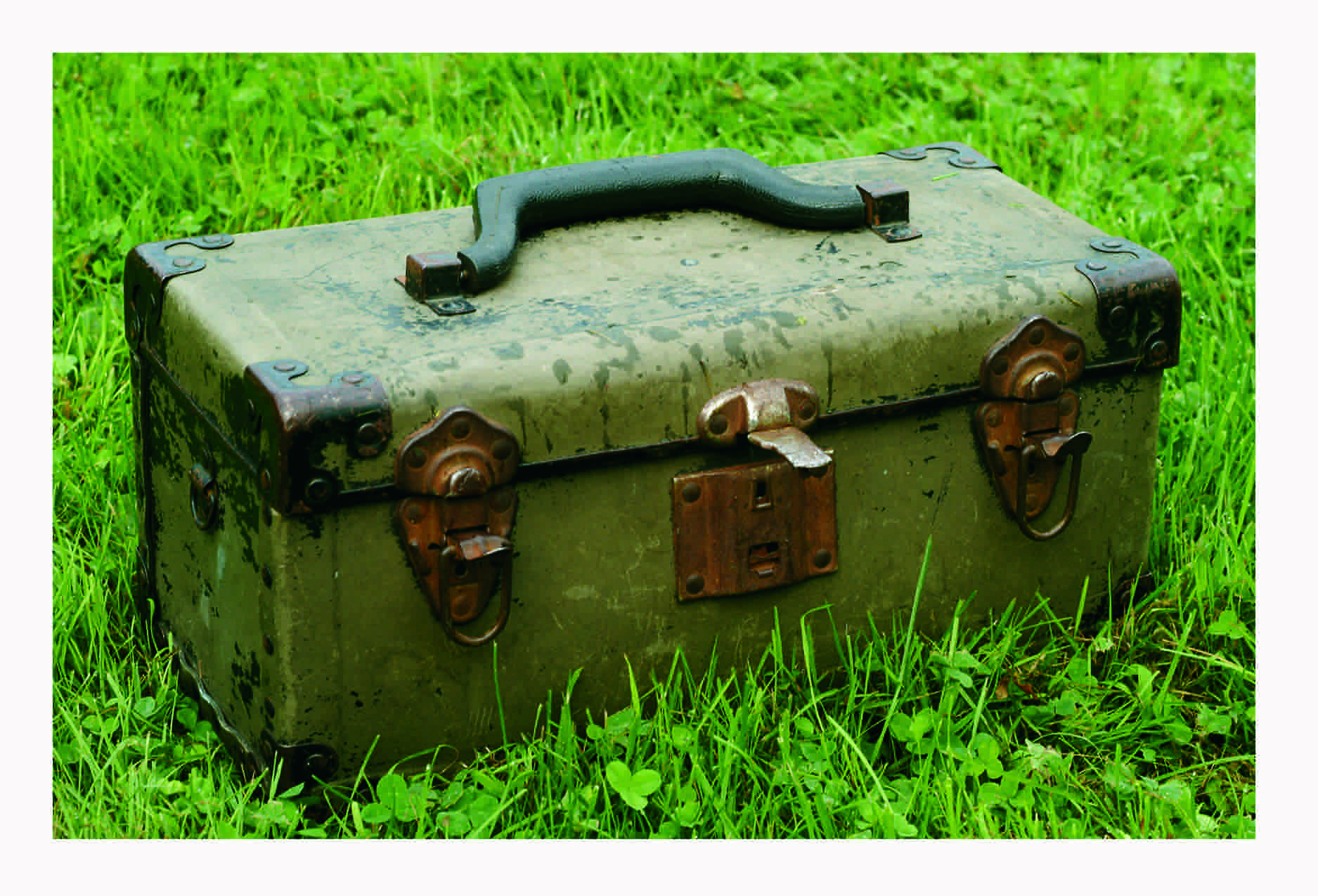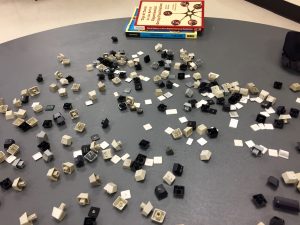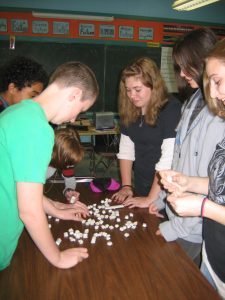
Mar 16, 2017 Re-Use, Repurpose, Upcycle
Excerpt from Tips & Tools for the Art of Experiential Group Facilitation, Second Edition by Jen Stanchfield
repurpose 1. To reuse for a different purpose, on a long-term
basis, without alteration. 2. To alter to make more suited for a
different purpose.
– MacMillan Dictionary
Upcycling is also known as creative reuse. With upcycling, an item that is no longer being used for its intended purpose but is repurposed— given a new purpose—and given added value. In my previous post, I mentioned improvisational facilitating. Don’t be afraid to repeat, re-use, or upcycle activities, materials, and/or props with a different purpose in mind. For example, my favorite rapport-building activities for starting a program can also be repurposed as excellent tools for engaging a group in meaningful reflection or closing a group experience later in a program. Some of my favorite ice-breakers and group-building games double as active academic teaching and review strategies (Inspired Educator Inspired Learner). As mentioned in chapter two, a junk drawer, old toolbox, or items from the kitchen cupboard can be upcycled as metaphoric reflection strategies.
When I use an activity like Handshake Mingle or Concentric Circles as an icebreaker or rapport-builder early in a group’s time together and then repeat it for content review, a check-in, or for reflection, I find the group doesn’t mind the repetition. Most participants enjoy going back to something familiar. When they are already comfortable with the structure and workings of the activity itself, they participate more readily in the reflective aspect of the new version or academic review variation. Think about your favorite activities, tools, and strategies and how they can be re-purposed for reflection or review. If a particular icebreaker activity sparks dialogue and builds rapport for a group, think about using it again for other conversations where the same quality of sharing is desired.
I explored an example of this re-purposing in my April 2011 Blog Post:
Computer Keyboard Keys
 Many years ago while providing a series of facilitation training sessions for social workers and counselors in a therapeutic youth program, I emphasized the value of using metaphoric objects/images in reflection. I encouraged the staff to take a look in their junk drawers for items they could add to their toolkit. When I arrived for my third session, Andy La Pointe, Career Development Specialist and Challenge Course Facilitator, handed me a bag filled with pieces of a computer keyboard. He remembered what I said about upcycling when he saw the stack of keyboards in the recycle bin, and it sparked an idea about using them in facilitation.
Many years ago while providing a series of facilitation training sessions for social workers and counselors in a therapeutic youth program, I emphasized the value of using metaphoric objects/images in reflection. I encouraged the staff to take a look in their junk drawers for items they could add to their toolkit. When I arrived for my third session, Andy La Pointe, Career Development Specialist and Challenge Course Facilitator, handed me a bag filled with pieces of a computer keyboard. He remembered what I said about upcycling when he saw the stack of keyboards in the recycle bin, and it sparked an idea about using them in facilitation.
We tried them that day with his colleagues. I was impressed with the conversation the keys initiated and the connections group members made to various keys. It can be surprising where conversation sand reflection can go with such a simple tool. Since then, I’ve collected more keyboard keys from Macs, PCs, and even old typewriters to use in introductory, transitional, and reflective activities. I find them in trash piles and recycle bins at schools, and computer stores often have trade-ins and pieces from non-working computers.
Materials: All types of old keyboard keys, with plenty of the command keys such as delete, alt, shift available in the mix.
Facilitation Suggestions
• Display the keyboard keys where all participants can access them.
• Different prompts fit different situations. With educators and facilitators, I invite them to, “Choose a keyboard key that represents something you are working on in your facilitation, or a goal you have for your work.”
• With groups working as a team on a task or project together, I use the keys to spur conversation on their roles, responsibilities, goals, and challenges with group process.
NOTES FROM THE FIELD… A teacher who attended a recent workshop reported back a few weeks later: “I really liked the keyboard activity you shared with us. I’ve used it in some team-building work with students, asking the question, ‘What was the hardest part about your work today?’ and in a staff training, asking, ‘How would you describe your teaching style?’ I see it as a good icebreaker for kids who have never met me before. The lesson was on how (Microsoft) Excel relates to their technology education project (truss bridges). I would like to convey that Excel will make their lives easier by simplifying the math involved. I plan to ask them, ‘Which key describes how you feel about math (or describes you as a math student)?’”
 Sandi Lindgren is a social worker who shared: “I used the keyboard keys yesterday and the group loved it! I was speaking to a senior class of social workers about research/surveys (sharing examples from my dissertation) and how to find their dream job as a social worker. I used the keys in the beginning as an introduction, asking them to choose a key that best represented where they currently were in their class’ research process. The professor was delighted with the on-point honest sharing that occurred. I then referenced their examples later on in the session. Examples included: The space key for taking a break and not really doing much with homework. The S key for stress. The tab key for taking a break (the old soft drink Tab). The group also pointed out that the tab key moves one forward. The page down key for feeling their process is really slow right now. The caps lock key for feeling so stressed they feel like everyone is talking to them in all CAPS, WHICH IS YELLING ON THE SCREEN (that was great).”
Sandi Lindgren is a social worker who shared: “I used the keyboard keys yesterday and the group loved it! I was speaking to a senior class of social workers about research/surveys (sharing examples from my dissertation) and how to find their dream job as a social worker. I used the keys in the beginning as an introduction, asking them to choose a key that best represented where they currently were in their class’ research process. The professor was delighted with the on-point honest sharing that occurred. I then referenced their examples later on in the session. Examples included: The space key for taking a break and not really doing much with homework. The S key for stress. The tab key for taking a break (the old soft drink Tab). The group also pointed out that the tab key moves one forward. The page down key for feeling their process is really slow right now. The caps lock key for feeling so stressed they feel like everyone is talking to them in all CAPS, WHICH IS YELLING ON THE SCREEN (that was great).”
One last example was a corporate training group focused on exploring new perspectives and moving away from fixed mind-sets and old habits. One participants shared: “I chose the F3 key because on “I chose the F3 key because on the computer this key opens new search screens. We as an organization need to focus on having an open mind and willingness to experiment with new ideas and approaches.” This ended up becoming a mantra for the rest of the training. When someone started to become inflexible in their thinking, a peer would say, “Come on, let’s F3 it!”
This re-purposing example is just one of many reflective techniques that involve sourcing items from junk drawers or yard sales for use in meaningful group dialogue. Chapter seven is devoted to the topic of reflection and the use of metaphor to enhance learning outcomes and weave meaningful processing and dialogue throughout your program. It offers a variety of engaging reflective tools and techniques to help learners find meaning and relevancy in their experiences. Many of these strategies are variations of activities used earlier in group work for community-building and re-purposed as reflective techniques. Others use artwork, journaling, movement, objects, games and other active strategies to promote multiple pathways to learning, enlivening the traditional sharing circle with active, brain-based reflection strategies to increase participant engagement, buy-in, and ownership.
Stanchfield (2014). Inspired Educator, Inspired Learner: Experiential, Brain-Based Activities and Strategies to Engage, Motivate, Build Community, and Create Lasting Lessons. Bethany, OK: Wood N Barnes Publishing.



No Comments